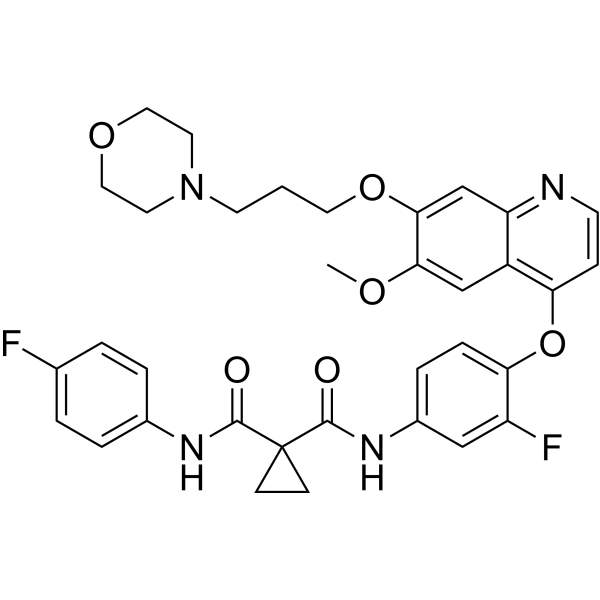Home
Products
Foretinib (GSK1363089)



| Product Name | Foretinib (GSK1363089) |
| Price: | Inquiry |
| Catalog No.: | CN00350 |
| CAS No.: | 849217-64-7 |
| Molecular Formula: | C34H34F2N4O6 |
| Molecular Weight: | 632.65 g/mol |
| Purity: | >=98% |
| Type of Compound: | Alkaloids |
| Physical Desc.: | Powder |
| Source: | |
| Solvent: | Chloroform, Dichloromethane, Ethyl Acetate, DMSO, Acetone, etc. |
| SMILES: | COc1cc2c(ccnc2cc1OCCCN1CCOCC1)Oc1ccc(cc1F)NC(=O)C1(CC1)C(=O)Nc1ccc(cc1)F |
| Contact us | |
|---|---|
| First Name: | |
| Last Name: | |
| E-mail: | |
| Question: | |
| Description | Foretinib is a multi-target tyrosine kinase inhibitor with IC50s of 0.4 nM and 0.9 nM for Met and KDR. |
| Target | KDR:0.9 nM (IC50) c-Met:0.4 nM (IC50) |
| In Vitro | Foretinib inhibits HGF receptor family tyrosine kinases with IC50 values of 0.4 nM for Met and 3 nM for Ron. Foretinib also inhibits KDR, Flt-1, and Flt-4 with IC50 values of 0.9 nM, 6.8 nM and 2.8 nM, respectively. Foretinib inhibits colony growth of B16F10, A549 and HT29 cells with IC50 of 40 nM, 29 nM and 165 nM, respectively[1]. A recent study indicates Foretinib affects cell growth differently in gastric cancer cell lines MKN-45 and KATO-III. Foretinib inhibits phosphorylation of MET and downstream signaling molecules in MKN-45 cells, while targets GFGR2 in KATO-III cells[2]. |
| In Vivo | Foretinib (100 mg/kg, p.o.) results in substantial inhibition of phosphorylation of B16F10 tumor Met and ligand (e.g., HGFor VEGF)-induced receptor phosphorylation of Met in liver and Flk-1/KDR in lung, which both persist through 24 hours. Foretinib (30-100 mg/kg, once daily, p.o.) results in reduction in tumor burden. The lung surface tumor burden is reduced by 50% and 58% following treatment with 30 and 100 mg/kg Foretinib, respectively. Foretinib treatment of mice bearing B16F10 solid tumors also results in dose-dependent tumor growth inhibition of 64% and 87% at 30 and 100 mg/kg, respectively. For both studies, administration of Foretinib is well tolerated with no significant body weight loss[1]. Foretinib is developed to target abnormal signaling of HGF through Met and simultaneously target several receptors tyrosine kinase involved in tumor angiogenesis. Foretinib causes tumor hemorrhage and necrosis in human xenografts within 2 to 4 hours, and maximal tumornecrosis is observed at 96 hours (after five daily doses), resulting in complete regression[3]. |
| Cell Assay | B16F10, A549, and HT29 cells (1.2×103 per well) are mixed with soft agar and seeded in a 96-well plate containing 10% FBS and EXEL-2880 over a base agar layer. For normoxic conditions, the plates are incubated (37°C) for 12 to 14 days in 21% oxygen, 5% CO2, and 74% nitrogen, whereas incubation (37°C) under hypoxic conditions is done in a hypoxia chamber in 1% oxygen, 5% CO2, and 94% nitrogen. The number of colonies is evaluated under each condition following addition of 50% Alamar Blue and fluorescence detection. |
| Animal Admin | In vivo target modulation studies are done in naive mice or mice bearing B16F10 tumors. Foretinib or vehicle (0.9% normal saline) is administered at 10 mL/kg via oral gavage. For examination of Met phosphorylation in liver, HGF (10 μg/mouse) is administered i.v. 10 min before harvest. For examination of Flk-1/KDR phosphorylation in lung, VEGF (10 μg/mouse) is administered i.v. 30 min before harvest 0.5 h later. Receptor phosphorylation analysis is determined by immunoblot analysis. |
| Density | 1.4±0.1 g/cm3 |
| Boiling Point | 828.5±65.0 °C at 760 mmHg |
| Flash Point | 454.8±34.3 °C |
| Exact Mass | 632.244629 |
| PSA | 116.45000 |
| LogP | 5.12 |
| Vapour Pressure | 0.0±3.0 mmHg at 25°C |
| Storage condition | -20°C |